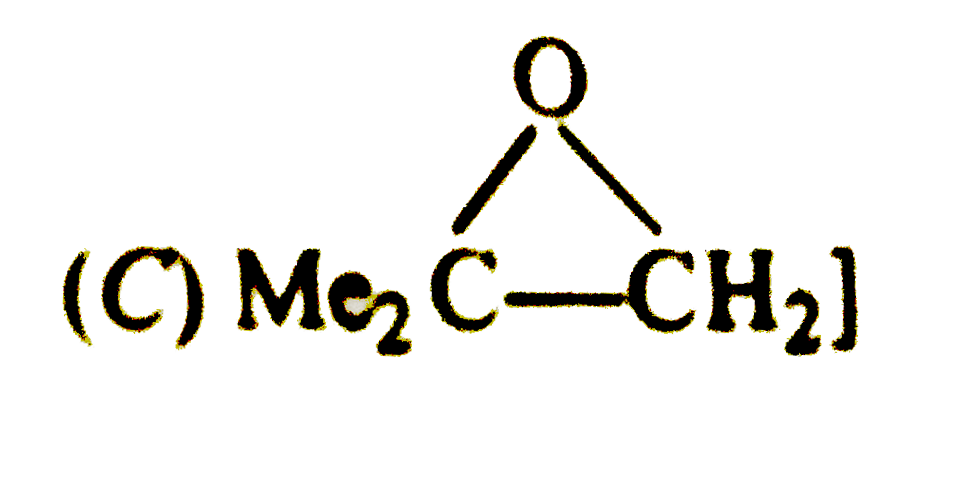CH3−CH=CH2Br2−−→773K[A]KOH(alc.)−−−−−−−→Heat[B]
To solve the given problem, we will break it down step by step.
Step 1: Identify the Reactant
The reactant given is propene, which has the structure CH₃-CH=CH₂.
Step 2: Reaction with Bromine (Br₂)
The first reaction involves propene reacting with bromine at a high temperature (773 K). At high temperatures, bromination occurs at the double bond, leading to the formation of a brominated product.
Product A:
When propene reacts with Br₂, the major product formed at high temperature is 1-bromopropene (CH₃-CHBr-CH₂). This is because the reaction favors the formation of a more stable product due to the elimination of bromine.
Step 3: Reaction with Alcoholic KOH
Next, the product A (1-bromopropene) undergoes a reaction with alcoholic KOH in the presence of heat. This reaction is an elimination reaction (dehydrohalogenation), where the bromine atom is eliminated along with a hydrogen atom from the adjacent carbon.
Product B:
The elimination leads to the formation of propene again, but in this case, it can also lead to the formation of allene (H₂C=C=CH₂) depending on the conditions. However, since we are focusing on the major product, we can conclude that the primary product B is allene.
Summary of Products
- Product A: 1-bromopropene (CH₃-CHBr-CH₂)
- Product B: Allene (H₂C=C=CH₂)
Final Answer
- A = 1-bromopropene (CH₃-CHBr-CH₂)
- B = Allene (H₂C=C=CH₂)
---
The reactant given is propene, which has the structure CH₃-CH=CH₂.
The first reaction involves propene reacting with bromine at a high temperature (773 K). At high temperatures, bromination occurs at the double bond, leading to the formation of a brominated product.
When propene reacts with Br₂, the major product formed at high temperature is 1-bromopropene (CH₃-CHBr-CH₂). This is because the reaction favors the formation of a more stable product due to the elimination of bromine.
Next, the product A (1-bromopropene) undergoes a reaction with alcoholic KOH in the presence of heat. This reaction is an elimination reaction (dehydrohalogenation), where the bromine atom is eliminated along with a hydrogen atom from the adjacent carbon.
The elimination leads to the formation of propene again, but in this case, it can also lead to the formation of allene (H₂C=C=CH₂) depending on the conditions. However, since we are focusing on the major product, we can conclude that the primary product B is allene.
- Product A: 1-bromopropene (CH₃-CHBr-CH₂)
- Product B: Allene (H₂C=C=CH₂)
- A = 1-bromopropene (CH₃-CHBr-CH₂)
- B = Allene (H₂C=C=CH₂)
Similar Questions
Knowledge Check
Supply structural formulae for missing compounds.
(i) H2C=CH2+(A)→ClCH2−CH2OHH2SO4−−−−−−→413K(B)alc. KOH−−−−−−−→Δ(C)
(ii) CH3CHBrCH3alc. KOH−−−−→(A)HBr−−−−−→Peroxide(B)CH3ONa−−−−−→(C)
(iii) Me3CBralc. KOH−−−−→(A)HOCl−−−→(B)NaOH−−−→(C)
 AABCCH3CH=CH2CH3CH(Br)CH2BrCH3CH(OH)CH3BABCCH3CH=CH2CH3CH2CH2BrCH3CH2OCH2CH2CABCCH2CH=CH3CH3CH(Br)CH3CH3CH2OCH2CH2DABCCH2CH=CH3CH3CH2CH2BrCH2CH2CH2OCH3
AABCCH3CH=CH2CH3CH(Br)CH2BrCH3CH(OH)CH3BABCCH3CH=CH2CH3CH2CH2BrCH3CH2OCH2CH2CABCCH2CH=CH3CH3CH(Br)CH3CH3CH2OCH2CH2DABCCH2CH=CH3CH3CH2CH2BrCH2CH2CH2OCH3
Complete the following reaction:
CH3CH2COOHP,Br2−−−→[A](i)alc.KOH(excess)−−−−−−−−−−−−−→(ii)H+[B]
View SolutionComplete the following reaction:
CH3CH2COOHP,Br2−−−→[A](i)alc.KOH(excess)−−−−−−−−−−−−−→(ii)H+[B]
View SolutionCH3−CH=CH2HBr−−−−→Peroxide[A]KOH(aq)−−−−−−→[B]H2SO4(conc.)−−−−−−−−−→443K[C]
View SolutionCH3BrNa−−→ether[A]Br2−−→hv[B]Na−−→ether[C]
View SolutionCH3COOHNaOH−−−→[A]NaOH−−−→CaO[B]Br2−−→hv[C]
View SolutionC6H5CH2CH(Cl)C6H5KOH(alc.)−−−−−→Heat[A]
View SolutionPh−CH2−CH=CH−CH3(i)Br2−−−−−−−−→(ii)Alc.KOH
View Solution